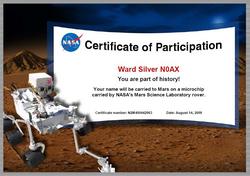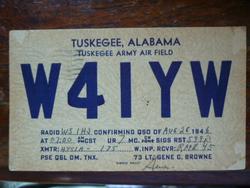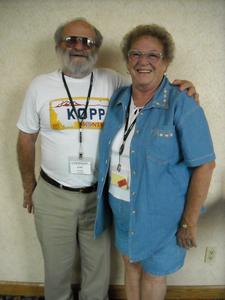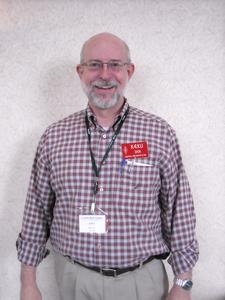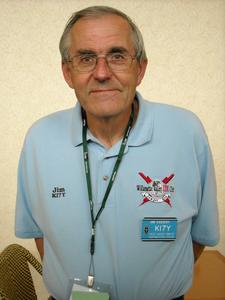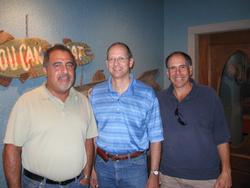 August 19, 2009 Editor: Ward Silver, NØAX | |||||||
IN THIS ISSUE
NEW HF OPERATORS - THINGS TO DO Work another of the state QSO parties and get a DXCC counter, too! The Hawaii QSO Party runs this weekend (and so does the larger Ohio QSO Party!) so you shouldn't have too much trouble finding a KH6 on a band or two. Don't forget to say, "Mahalo!" (thank you), as well. BULLETINS There are no bulletins in this issue. (Note - the Kansas QSO Party listing was added after the issue was released - N0AX.) BUSTED QSOS Dave KA1NCN/KL7 and David WA9C (ex-NL7P) were nice enough to gently let me know that you can't drive to Barrow. Prudhoe Bay, yes, Barrow, no. CONTEST SUMMARY Complete information for all contests follows the Conversation section Aug 22-23
Aug 29-30
NEWS, PRESS RELEASES, AND GENERAL INTEREST Good news on the Year of the State QSO Party front! South Dakota checks in with the last of the state QSO parties - we've got a sweep! And they do mean "last" as the event will be held on New Year's Eve, Dec 31st, before the traditional ARRL Straight Key Night. In other state QSO party news, the official New York State QSO Party Forum is live and online. Anyone interested in the NYQP on October 17th or who intends to operate in the contest is encouraged to register with this forum and post their county activity. (Thanks, Rochester DX Association & NYQP Team, Paul K2DB)
This would be one of the greatest "roves" ever! Your name and call could be headed to the Red Planet in 2011 printed on a microchip in the Mars Science Laboratory Rover. According to a report by VK2SKY in the Amateur Radio Newsline report for August 7th, what you have to do is log on to the JPL Web site for the mission and enter your name and call. I entered "NØAX" right after my last name and as you can see from the certificate, I'm going to Mars! The same issue of Newsline directs us to a set of free IARU locator maps turned up by GØGQK. There are lots of maps from all over the world. They're in PDF format for convenient download and display. One of the oldest brands in ham antennas, Cushcraft, has been sold to MFJ Enterprises. The antennas will continue to be manufactured in New Hampshire. MFJ has set up a special customer support line at (662-323-5803) to handle Cushcraft antenna product technical support, parts requests and customer services. The next MFJ catalog will include the entire Cushcraft amateur product line. MFJ also distributes the line of Hy-Gain antennas Competitors in the ARRL EME Contest have been discussing the elimination of the Assisted categories from that contest. If you are wondering about the rationale, take a look at the EME white paper that discusses the contest and how the decision was made. (Thanks, Jon WØZQ) There's a silver lining in every dark cloud...in this case a copper lining. Steve K7AWB reports that wire prices are dropping at the hardware retail emporia. Copper prices have plummeted along with our investment portfolios and so that 80 meter Sterba Curtain may be affordable once again, even if not buildable. Time to stock up, perhaps? The Contest University (CTU) returns to England on October 10, 2009! If you missed CTU Dayton and CTU Italy this year, here is another chance to attend Contest University - this time hosted by Mark MØDXR as part of the upcoming RSGB convention. (Thanks, Tim K3LR)
In case you missed the ARRL Web news story, Scott KØDQ recently became the first operator to win all six of the "majors" - both modes of CQ WW, ARRL DX, and CQ WPX! Congratulations to Scott and I'm sure the digital operators are now looking over their shoulders! Web Site of the Week The CQ WPX Contest Committee invites you to share your feedback on the contest by taking a short survey. The responses will be used to improve the contest and it should take less than five minutes to complete. (CQ WPX Director, Randy K5ZD) WORD TO THE WISE Penalty - The penalties assessed during log checking for a busted call, miscopied exchange, or "not in the log" QSO are there to create an incentive for accurate copy. No, a penalty is NOT an accusation of cheating...it's just a "mistake fee" like the five yards assessed for an offsides infraction in football. There is a lot of confusion about what the penalty consists of: First, the bad QSO is removed, as should be expected. Then, a number of QSO points equivalent to the number of penalty QSOs are subtracted from your total - actual additional QSOs are not removed from the log. For example, should I bust an intercontinental QSO in CQ WW, that QSO will be deleted from my log and an additional nine points (three QSOs worth) will be subtracted from my total. This is sufficient penalty for me to slow down and get all the information right before logging the contact - and that's one of the reasons we have ham radio contests! SIGHTS AND SOUNDS Here's a chance to get a sneak peak of what WRTC 2010 will look like! Another in the series of Potomac Valley Radio Club webinars will present a look at the Field Day style operation of the Russian Radiosport Team Championship held last month. Click on the "Webinar" link on the main page. You can also past webinars. At the bottom of the page is a link to the Webinar Quick Reference users guide. These are great for club meetings, too!
Brian W9IND writes to let us know that the operator featured in the video "Night of Nights" featured in the previous issue is actually Denice, not Denise. KI6BBR is a General class licensee, as well. I'll bet she could have passed the old 20 WPM test without breaking a sweat, don't you? RESULTS AND RECORDS The extended Web version of the 2009 ARRL DX Phone contest results are now on-line. Your editor, author of those results, is grateful for the assistance of the volunteers that generated regional writeups for every ARRL Division and continents around the world! Here are a couple of corrections to previous ARRL contest writeups:
(Thanks, ARRL Contest Branch Manager, Sean KX9X)
The Michigan QSO Party Committee is pleased to announce that the results of the 2009 MiQP are now available on-line. (Thanks, Dave K8CC) Pascal F5LEN reports that the results of the French HF Meteor scatter enthusiasts should note that the results of "Summer MS Contest 2009" are available. (Thanks, Summer MS Committee - Ilija YU7PAA, Zoran YU7ON, Bane YU7KB) OPERATING TIP Know Your Categories! As all contest sponsors know, an occasional competitor is "surprised" to find out that his or her log turns up in a category or with some other attribute they didn't intend for their submission! How does this happen? Sometimes, there just ISN'T a category like you expected! For example, in ARRL contests, the Single-Band categories do not recognize power level and there is only one Assisted category, no matter what! Even if you are aware of the category structure, you can still be "hosed" by the logging software when a menu selection or check box is retained from a previous contest or the program defaults aren't reset and, voila! Where did your score go? You wouldn't have sent in your paper logs without making a quick review of the summary sheet, dupe sheet, and logs, would you? Of course not, so here's how to make a quick check of your Cabrillo-formatted log on a Windows-based PC:
This simple process prevents those very unpleasant discoveries when the results are published! All of the Cabrillo tags and the options associated with each are described on the Cabrillo Standard Web site. TECHNICAL TOPICS AND INFORMATION If you have an old power tube and want to use it in an amplifier, the consensus is that the years of sitting allow contaminants to build up in the vacuum. That means the tube needs "gettering" - a period of heating to allow the contaminant absorbing materials in the tube to soak up the unwanted molecules. Ian GM3SEK relays the following procedure, obtained from an Eimac employee years ago and summarized here. While supplying the necessary cooling,
This allows the getter to experience a spectrum of temperatures, mopping up different species of contaminants at different temperatures. For example, the 3-500Z, has getters at the base of the grid and the base of the filament as well as sprayed on the anode. While this conditioning schedule is seemingly over-complicated and ultra-conservative, it should result in no surprises when putting the tube into service. Terms like "a few hours" are vague because different tubes require different treatment. If you are "burning in" a monster tube that will cost us $50,000 to replace, be more conservative than with a $50 tube. When you are installing a new ac outlet in the shack, make sure the current rating of the outlet and the circuit match. Says Paul W9AC, "I've seen instances where a 20-amp 120VAC receptacle is used, but the conductors are sized at #14 AWG. Looking at the receptacle gives the incorrect impression that the branch is rated for 20 amps, when in fact it's only rated at 15 amps. The breaker rating, wire size, receptacle and plug should all match the intended current-carrying capacity."
What about international power connections if you are traveling outside the US? There are so many different power systems and connector standards that it's hard to figure out how to prepare. Here's a US Department of Commerce document that presents just about everything you need to know in one simple document. (Thanks, Mark K1RO) Guy wires can be insulated with one piece of hardware called an "insulator clevis." Frank W3LPL recommends the Joslyn J732. Here's how he does it - "Attach the insulator clevis to your tower guy attachment hardware. You may need a 5/16- or 3/8-inch shackle to do this. Pass the clevis bolt through your guy wire insulator. Pass your guy wire (or preform) through the other hole in the guy wire insulator. The rated strength of the Joslyn J732 is 20,000 pounds." These can be ordered from your local electrical equipment distributor or from sources found on the Web. Resistance soldering tools brought several responses. Rick N6RK says that the 120-watt plumbing tool featured in the last issue just doesn't have enough power to heat a PL-259. Yet Spencer K5GAK reports success replacing the tip from his soldering gun with the PL-259. It may be that some other mechanism (such as heat at the contact point) is doing the temperature raising and not current flow through the bulk resistance of the connector. Your mileage may vary! Phased arrays of receiving antennas are starting to become more common on the low bands where they improve the signal-to-noise ratio (SNR) by rejecting noise away from the "line of fire." Carlos N4IS relays an article by Dallas Lankford about the Quad Delta Flag, focusing on maximum front-to-back ratio. He also reminds us that interaction with nearby antennas (or any conductor a significant fraction of a wavelength long) and common mode noise can drastically compromise the performance of a receive antenna. That's no reason not to try one, though, even on a small lot. Following up on the phased array, many engineering texts on the subject focus (so to speak) on radar applications with limited utility on our lower frequency bands. Rudy N6LF recommends, "Theory and Application of Antenna Arrays" by M.T. Ma, from Wiley-Interscience, published in 1974. It's relatively easy to read without too much math and a lot of the material is quite useful on Top Band. I often cite Jim K9YC's tutorials on ferrite use, but he has published numerous other papers and presentations. This set of presentation sides on audio interfaces is something a digital operators should browse and consider. Understanding the source of noise often points the way to solutions, as well! Whether or not you use the Honda EU-series of portable generators, Honda has published a lot of useful information on sizing and selecting home generators. Further, connecting a generator to your home wiring is also covered. (Thanks, Robert Morris) Technical Web Site of the Week - There is a very good Height Above Average Terrain (HAAT) calculator available at the FCC Web site. Enter your coordinates and get the HAAT in all directions, with resolution selectable down to 1 degree radials. It only covers HAAT from 3 to 20 km, so you still need to avoid very local terrain features. (Thanks, Jim K8MR) CONVERSATION First-Order Runability Jamie and Adam, of Mythbusters television show fame, have been getting a lot exposure lately. For example, they were consulting editors for an issue of Popular Science and they're also in the process of shooting new shows to keep us all entertained (and educated) this fall. Both have their own workshops, as you might imagine, but Adam's is not the large every-tool-known version. It's actually quite small - just 10' by 12'. In describing the shop, Adam used the term "first-order retrieveability," meaning accessing anything he needs without having to look for it.
I'm a long-time fan of "FOR", I discovered! My December 2004 QST "Hands-On Radio" column, "Open House In the NØAX Lab" shows some of the tricks and techniques I used to maintain FOR of materials, components, tools, and test instruments. The same inclination extends to the ham station and all the gadgets and gew-gaws that go with that. I don't have a lot of space for station or shop and I'm a pretty busy guy, so I don't have a lot of time to waste looking for that stash of #8 solder lugs or to go on a "tool hunt" when I'm looking for the 5/16" nutdriver. FOR is not so much about neatness as it is about organization. We all know folks whose shops or shacks are immaculate, but if it's not sitting out in plain sight, they can't find it. Conversely, we have all visited techno-lairs with bits and pieces scattered in violent disarray, yet the owners can instantly put their hands on whatever is needed at any time. Not only does FOR save time, but there is a second-order effect that may be even more important and that is of keeping one's train of thought on the rails. I am very distractable, so replacing that image or concept in my mind with the process of looking for something often means that I have to start that mental buildup all over again. Tom DeMarco and Timothy Lister talk about this kind of disruption in their excellent book, Peopleware, in which they talk about the modern knowledge foundry and how to get the most out of employees hired for their brains rather than brawn. Does this pertain to contesting? Oh, my, does it! When you're in the groove of running stations or tuning the bands for new multipliers, any extra hand motions, mouse clicking, button pushing, annunciator beeps, flashing graphics, and so on are competing for your attention and diluting your focus. For example, I like the "Enter Sends Mode" of N1MM (originated by TR-LOG) in which my hands never have to move from home position on the keyboard. Hear call, type call, hit Enter to send my exchange, type in their exchange, hit Enter to send thanks and QRZ. Repeat. In this instance, FOR stands for First-Order Runability. So my point is (at last!) that as you build up your station and begin that long journey to the Top Ten, you need to spend a surprising amount of effort in its configuration; both of equipment and of the human interface to the software. Just as a competitive long-distance runner minimizes unnecessary motion, particularly energy-draining ups-and-downs, the competitive long-duration contester has to minimize unnecessary processes that divert and distract. During the next contest, try to "watch yourself" as you go about the business of operating. Do you have to swivel your head to see all the necessary equipment? Do you have to move your hands away from the keyboard? Can you tune the radio conveniently? Can you change bands quickly and efficiently? I've seen some of the really top operators go about their business and it's eerie at how easy they make it look - no thrashing about, no momentary flurries, no panics, no drama. Just one QSO after another going into the log a little bit faster than you or me, every single time, for hours and hours and hours. No wonder, because they have achieved first-order runability! CONTESTS 19 August to 1 September An expanded, downloadable version of QST's Contest Corral in PDF format is available. Check the sponsor's Web site for information on operating time restrictions and other instructions. HF CONTESTS Hawaii QSO Party--Phone,CW,Digital, from Aug 22, 0700Z to Aug 23, 2200Z. Bands (MHz): 1.8-28. Exchange: RS(T), S/P/C or maritime region or HI county. Logs due: 30 days. Rules Ohio QSO Party--Phone,CW, from Aug 22, 1600Z to Aug 23, 0400Z. Bands (MHz): 3.5-28. Exchange: Serial and S/P or "DX". Logs due: 30 days. Rules EPC Russia Contest--Digital,from Aug 22, 0300Z to Aug 23, 0300Z. 3.5-28. Exchange: EPC Russia number or RST and grid square. Logs due: Sep 17. Rules EPC Russia Contest--Digital, from 22 Aug, 0300Z to 23 Aug, 0300Z. Bands (MHz): 3.5-28. Exchange: EPC member nr or RST and grid square. Logs due: Sep 17. Rules ALARA Contest--Phone,CW, from Aug 29, 0600Z to Aug 30, 1159Z. Bands (MHz): 3.5-28. Exchange: RS(T), serial, ALARA nr, name. Logs due: Sep 30. Rules YO DX Contest--Phone,CW, from Aug 29, 1200Z to Aug 30, 1159Z. Bands (MHz): 3.5-28. Exchange: RS(T), serial or YO district. Logs due: 30 days. Rules SCC RTTY Championship--Digital, from Aug 29, 1200Z to Aug 30, 1159Z. Bands (MHz): 3.5-28. Exchange: RST, 4-digit year first licensed. Logs due: Sep 15. Rules Kansas QSO Party--Phone,CW,Digital, from Aug 29, 1400Z to Aug 30, 2000Z. Bands (MHz): 3.5-28, 50, 144. Exchange: RST and KS county or S/P/"DX". Logs due: Oct 1. Rules South Africa DX Contest--CW, from Aug 30, 1400Z to Aug 30, 1600Z. Bands (MHz): 3.5-14. Exchange: RS and serial. Logs due: 15 days. Rules VHF+ CONTESTS No VHF+ contests are scheduled. LOG DUE DATES 19 August to 1 September August 19, 2009 DMC RTTY Contest, Email logs to: dmcrtty@digital-modes-club.org, Paper logs and diskettes to: DMC Contest Committee, P.O. Box 8, 6000 Stara Zagora, Bulgaria. Rules August 20 - DIE Contest, Email logs to: ea5aen@ure.es, Paper logs and diskettes to: EA5AEN, Apartado 9055 en, 46080 Valencia, Spain. Rules August 20 - RSGB 80m Club Sprint, CW, Email logs to: cwsprint.logs@rsgbhfcc.org, Upload log at: http://www.vhfcc.org/cgi-bin/hfcover.pl, Paper logs and diskettes to: (none). Rules August 24 - WAE DX Contest, CW, Email logs to: waecw@dxhf.darc.de, Paper logs and diskettes to: (none). Rules August 31 - Venezuelan Ind. Day Contest, Email logs to: contestyv@cantv.net, Paper logs and diskettes to: Radio Club Venezolano, Concurso Independencia de Venezuela, P.O. Box 2285, Caracas 1010-A, Venezuela. Rules August 31 - Portugal Day Contest, Email logs to: rep-concursos@rep.pt, Paper logs and diskettes to: REP Award/Contest Manager, Rua D. Pedro V, No. 7-40, 1250-092 Lisboa, Portugal. Rules August 31 - European HF Championship, Email logs to: euhfc@hamradio.si, Paper logs and diskettes to: Slovenia Contest Club, Saveljska 50, 1000 Ljubljana, Slovenia. Rules August 31 - International Lighthouse-Lightship Weekend QSO Contest, Email logs to: (none), Paper logs and diskettes to: Dave Ruch, NF0J, P.O. Box 20696, Bloomington, MN 55420-0696, USA. Rules September 1 - VK Shires Contest, Email logs to: contest@vkshires.info, Paper logs and diskettes to: (none). Rules September 1 - ARRL UHF Contest, Email logs to: AugustUHF@arrl.org, Paper logs and diskettes to: August UHF Contest, ARRL Contest Branch, 225 Main St., Newington, CT 06111, USA. Rules September 1 - CQ Worldwide VHF Contest, Email logs to: cqvhf@cqww-vhf.com, Paper logs and diskettes to: CQ VHF Contest, 25 Newbridge Road, Hicksville, NY 11801, USA. Rules September 1 - TARA Grid Dip Shindig, Email logs to: (none), Post log summary at: http://www.n2ty.org/seasons/tara_grid_score.html, Paper logs and diskettes to: (none). Rules ACKNOWLEDGEMENTS ARRL Contest Update wishes to acknowledge information from WA7BNM's Contest Calendar and SM3CER's Contest Calendar.
| |||||||
